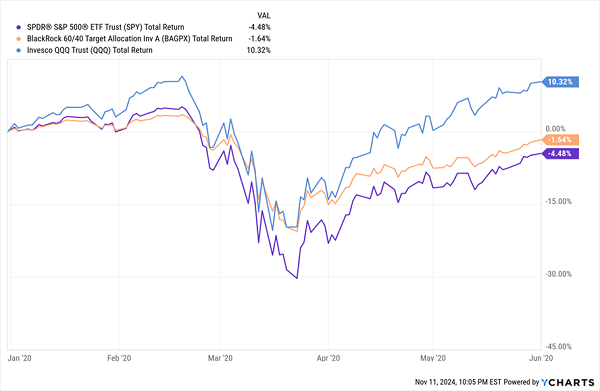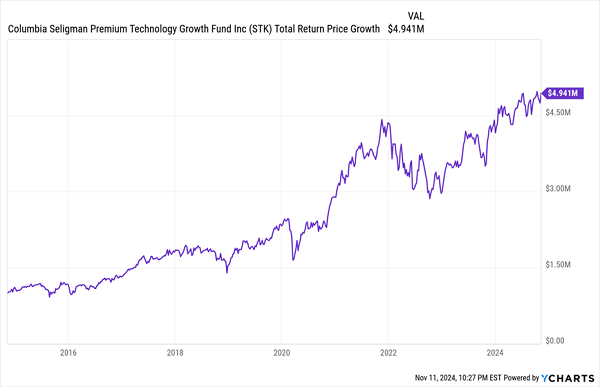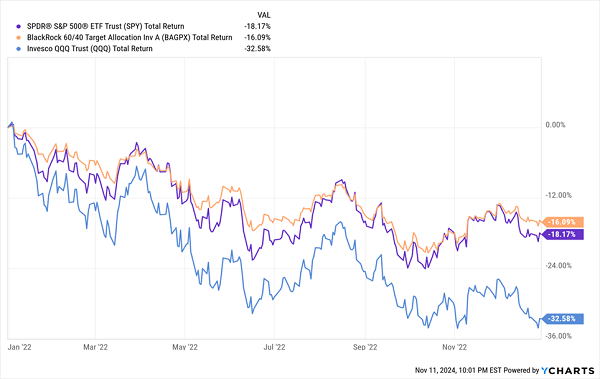Dump This ‘Sacred Cow’ Investment Rule and Break Free With 5.5%+ Yields
2024.11.18 07:55
If you have a wealth manager working for you, I have one simple piece of advice: Seriously consider moving on from them (or managing your investments yourself) if they recommend following the “60/40” rule.
It simply says that most people should invest 60% of their assets in stocks and 40% in government bonds for retirement.
In a moment, we’ll talk about one fund we’d have completely missed out on by following 60/40 ourselves—or by signing on with a wealth manager who does so. (And not to worry, this one is still available for us to tap into for a solid 5.5% dividend, with upside.)
60/40’s Oddball Origin Story
We don’t need to dive too deep into the economic weeds here, but the origin of the 60/40 rule is an interesting tale, so let’s take a side trip into it for a moment.
The rule emerged in the 1950s, as a group of advisors tried to integrate the Nobel Prize–winning research of Harry Markowitz, who founded Modern Portfolio Theory (MPT), an important concept in diversification.
Advocates of 60/40 like to say it’s part of MPT, but it isn’t. Markowitz himself began with a 50/50 allocation for his own assets, which, he said, he did “to minimize my future regret.”
He also did it without doing an actual analysis of the data: “I should have computed the historical co-variances of the asset classes and drawn an efficient frontier. Instead, I visualized my grief if the stock market went way up and I wasn’t in it—or if it went way down and I was completely in it.”
So the 60/40 rule comes from a misunderstanding of a bias that inspired a Nobel Prize–winning economist to build a theory. It isn’t the conclusion of the theory he developed!
A Flawed “Rule”
To delve into the flaws of this approach, let me first state that we’re not abandoning diversification here—far from it! The flaw of this rule, though, is that it doesn’t allow us to weight more of our portfolio toward the market’s fastest-growing assets when there’s an opportunity to do so. It also, of course, doesn’t consider an investor’s individual goals and age.
To see its flaws in action, imagine an investor in 2006 steps into a wealth manager’s office looking to weight more of their portfolio toward tech, since the internet is growing more popular, smartphones are catching on, and tech still hasn’t recovered from the dot-com crash.
The wealth manager discourages her, stating that for true diversification and safety, she should use the tried-and-true 60/40 portfolio. Fast forward nearly 20 years later, and you can see how 60/40 did versus the and the .

Source: CEF Insider
It would have been bad advice. As you can see, an investor who put in $10,000 per year has missed out on about $700,000 following the 60/40 plan versus the NASDAQ 100 over this time period, and about $300k over the S&P 500.
Now again, we’re not saying ignoring asset classes beyond stocks is the way to go here—just that a flexible approach would’ve resulted in far greater returns than simply following a “rule” like 60/40.
Some wealth managers might respond to this by saying that the 60/40 portfolio cuts our volatility. That’s partly true. For instance, in 2022 the NASDAQ 100 saw big declines, and the 60/40 portfolio did much better. It still lost money, but it lost a lot less.
Less Volatility for 60/40
Above we have a fund representing the 60/40 portfolio (in orange), compared to benchmark index funds for the S&P 500 (in purple) and NASDAQ (in blue).
Note that the 60/40 portfolio’s 16.1% decline isn’t much smaller than the S&P 500’s 18.2% slide in the same year, so the portfolio didn’t really help fight volatility in stocks. The 60/40 portfolio just wasn’t exposed to the much more volatile tech-focused NASDAQ 100 index.
What about worse declines in the past, like the 2008/2009 crisis? Well, that was awful for stocks, so the 60/40 portfolio (again in orange below) did better than the S&P 500 (in purple). But it actually did much worse than the NASDAQ 100 (in blue).
More Volatility for 60/40

This makes sense if you stop and think about it. When the subprime-mortgage crisis hit, the NASDAQ 100 was still significantly down due to the popped dot-com bubble, so it had less room to fall than the S&P 500 and the 60/40 portfolio.
What about the COVID-19 pandemic? This is another time when you’d expect the volatility protection of the 60/40 portfolio to outperform. Except it didn’t.
60/40 Fails Again

This time the NASDAQ 100 won, recovering from its slump to show a strong return pretty quickly—and for obvious reasons, as the pandemic was a boon for tech providers like Zoom Video Communications (NASDAQ:), Amazon.com (NASDAQ:) and Uber Technologies (NYSE:).
The key takeaway from all of this is that following a strict rule (“always have a 60/40 allocation”) is a losing approach. Being nimble and shifting with market conditions generates a lot more wealth for us.
Granted, that’s hard to do, especially in the moment, when emotions are running hot.
One solution is to buy a diversified and well-managed tech closed-end fund (CEF) that pays out a large portion of its profits in dividends, like the 5.5%-yielding Columbia Seligman Premium Technology Growth Fund (NYSE:).
With an above-average payout, we’re getting more of our return in safe dividend cash, which we can use to reinvest in the fund or keep in our accounts, letting it accumulate and naturally tone down our risk.
Further cutting our risk is the fact that STK focuses on large cap techs, with Microsoft (NASDAQ:), Apple (NASDAQ:) and Oracle (NYSE:) among its top holdings. The fund also trades at a 2% discount to net asset value (NAV, or the value of its underlying holdings), well below its five-year average of 3.6%, so we’re getting some downside insulation (and upside!) through the markdown on this one.
Then there’s the performance: With a 17.6% annualized return over the last decade, STK has been a massive wealth provider for investors. If you’d invested $1 million a decade ago and reinvested your dividends, your initial buy would be worth $4.9 million as of this writing.
STK Is a Serious Wealth Generator

That just proves the point that it’s more profitable to move into, and out of, high-quality CEFs (which are themselves actively managed) from various asset classes as market conditions change. By doing so, you’ll get the opportunity to get in at a discount (something you can’t do with ETFs) and pocket a high yield.
By the way, most CEFs yield more than STK—an average of 8% today—and they come from across the economy, holding real estate investment trusts (REITs), blue chip stocks, corporate bonds and more.
Plus they actually grow your wealth more than parking 40% of your portfolio in low-returning government bonds would, so they easily outperform the 60/40 portfolio.
These 5 “Secret” (for Now!) CEFs Yield 10.5%—and They’re Still Cheap
CEFs are a terrific option now because there are plenty of bargains still available in the space, even after the big post-election run-up we’ve seen in stocks.
Yet most folks have no idea these deals (with their huge—and often monthly paid—dividends) are still available.
That’s fine—more buys in the bargain aisle for us!
We’ll start with the 5 CEFs I’m pounding the table on now. They come from across the economy, and they crush 60/40 because they trade at deep discounts (so much so that I’m calling for 20%+ potential price upside from these 5 funds in the next year) and kick out a huge 10.5% average dividend, too!
Now is the time to buy them, before the income-focused crowd catches on.









